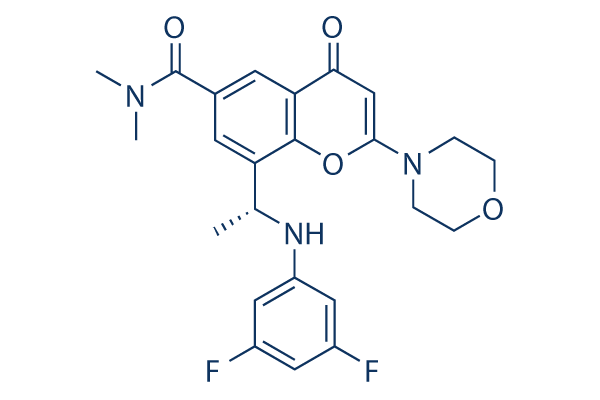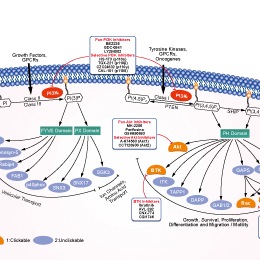
- Bioactive Compounds
- By Signaling Pathways
- PI3K/Akt/mTOR
- Epigenetics
- Methylation
- Immunology & Inflammation
- Protein Tyrosine Kinase
- Angiogenesis
- Apoptosis
- Autophagy
- ER stress & UPR
- JAK/STAT
- MAPK
- Cytoskeletal Signaling
- Cell Cycle
- TGF-beta/Smad
- DNA Damage/DNA Repair
- Compound Libraries
- Popular Compound Libraries
- Customize Library
- Clinical and FDA-approved Related
- Bioactive Compound Libraries
- Inhibitor Related
- Natural Product Related
- Metabolism Related
- Cell Death Related
- By Signaling Pathway
- By Disease
- Anti-infection and Antiviral Related
- Neuronal and Immunology Related
- Fragment and Covalent Related
- FDA-approved Drug Library
- FDA-approved & Passed Phase I Drug Library
- Preclinical/Clinical Compound Library
- Bioactive Compound Library-I
- Bioactive Compound Library-Ⅱ
- Kinase Inhibitor Library
- Express-Pick Library
- Natural Product Library
- Human Endogenous Metabolite Compound Library
- Alkaloid Compound LibraryNew
- Angiogenesis Related compound Library
- Anti-Aging Compound Library
- Anti-alzheimer Disease Compound Library
- Antibiotics compound Library
- Anti-cancer Compound Library
- Anti-cancer Compound Library-Ⅱ
- Anti-cancer Metabolism Compound Library
- Anti-Cardiovascular Disease Compound Library
- Anti-diabetic Compound Library
- Anti-infection Compound Library
- Antioxidant Compound Library
- Anti-parasitic Compound Library
- Antiviral Compound Library
- Apoptosis Compound Library
- Autophagy Compound Library
- Calcium Channel Blocker LibraryNew
- Cambridge Cancer Compound Library
- Carbohydrate Metabolism Compound LibraryNew
- Cell Cycle compound library
- CNS-Penetrant Compound Library
- Covalent Inhibitor Library
- Cytokine Inhibitor LibraryNew
- Cytoskeletal Signaling Pathway Compound Library
- DNA Damage/DNA Repair compound Library
- Drug-like Compound Library
- Endoplasmic Reticulum Stress Compound Library
- Epigenetics Compound Library
- Exosome Secretion Related Compound LibraryNew
- FDA-approved Anticancer Drug LibraryNew
- Ferroptosis Compound Library
- Flavonoid Compound Library
- Fragment Library
- Glutamine Metabolism Compound Library
- Glycolysis Compound Library
- GPCR Compound Library
- Gut Microbial Metabolite Library
- HIF-1 Signaling Pathway Compound Library
- Highly Selective Inhibitor Library
- Histone modification compound library
- HTS Library for Drug Discovery
- Human Hormone Related Compound LibraryNew
- Human Transcription Factor Compound LibraryNew
- Immunology/Inflammation Compound Library
- Inhibitor Library
- Ion Channel Ligand Library
- JAK/STAT compound library
- Lipid Metabolism Compound LibraryNew
- Macrocyclic Compound Library
- MAPK Inhibitor Library
- Medicine Food Homology Compound Library
- Metabolism Compound Library
- Methylation Compound Library
- Mouse Metabolite Compound LibraryNew
- Natural Organic Compound Library
- Neuronal Signaling Compound Library
- NF-κB Signaling Compound Library
- Nucleoside Analogue Library
- Obesity Compound Library
- Oxidative Stress Compound LibraryNew
- Plant Extract Library
- Phenotypic Screening Library
- PI3K/Akt Inhibitor Library
- Protease Inhibitor Library
- Protein-protein Interaction Inhibitor Library
- Pyroptosis Compound Library
- Small Molecule Immuno-Oncology Compound Library
- Mitochondria-Targeted Compound LibraryNew
- Stem Cell Differentiation Compound LibraryNew
- Stem Cell Signaling Compound Library
- Natural Phenol Compound LibraryNew
- Natural Terpenoid Compound LibraryNew
- TGF-beta/Smad compound library
- Traditional Chinese Medicine Library
- Tyrosine Kinase Inhibitor Library
- Ubiquitination Compound Library
-
Cherry Picking
You can personalize your library with chemicals from within Selleck's inventory. Build the right library for your research endeavors by choosing from compounds in all of our available libraries.
Please contact us at info@selleckchem.com to customize your library.
You could select:
- Antibodies
- Bioreagents
- qPCR
- 2x SYBR Green qPCR Master Mix
- 2x SYBR Green qPCR Master Mix(Low ROX)
- 2x SYBR Green qPCR Master Mix(High ROX)
- Protein Assay
- Protein A/G Magnetic Beads for IP
- Anti-Flag magnetic beads
- Anti-Flag Affinity Gel
- Anti-Myc magnetic beads
- Anti-HA magnetic beads
- Poly DYKDDDDK Tag Peptide lyophilized powder
- Protease Inhibitor Cocktail
- Protease Inhibitor Cocktail (EDTA-Free, 100X in DMSO)
- Phosphatase Inhibitor Cocktail (2 Tubes, 100X)
- Cell Biology
- Cell Counting Kit-8 (CCK-8)
- Animal Experiment
- Mouse Direct PCR Kit (For Genotyping)
- New Products
- Contact Us
research use only
AZD8186 PI3K inhibitor
AZD8186 is a potent and selective inhibitor of PI3Kβ and PI3Kδ with IC50 of 4 nM and 12 nM, respectively. Phase 1.

Chemical Structure
Molecular Weight: 457.47
Purity & Quality Control
Batch:
Purity:
99.99%
99.99
Related Products
| Related Targets | p110α p110β p110δ p110γ C2β Vps34 | Click to Expand |
|---|---|---|
| Related Products | LY294002 3-Methyladenine (3-MA) Dactolisib (BEZ235) Pictilisib (GDC-0941) Wortmannin Buparlisib (BKM120) PI-103 TGX-221 ZSTK474 Omipalisib (GSK2126458) A66 PF-04691502 PIK-75 HCl IC-87114 740 Y-P (PDGFR 740Y-P) AS-605240 Taselisib (GDC 0032) SAR405 Apitolisib (GDC-0980) VPS34-IN1 | Click to Expand |
| Related Compound Libraries | Kinase Inhibitor Library PI3K/Akt Inhibitor Library Apoptosis Compound Library Cell Cycle compound library NF-κB Signaling Compound Library | Click to Expand |
Signaling Pathway
Cell Culture and Working Concentration
| Cell Lines | Assay Type | Concentration | Incubation Time | Formulation | Activity Description | PMID |
|---|---|---|---|---|---|---|
| MDA-MB-468 | Function assay | 2 hrs | Inhibition of PI3Kbeta in PTEN-null human MDA-MB-468 cells assessed as inhibition of Akt phosphorylation after 2 hrs, IC50=0.003μM | 25514658 | ||
| Jeko B | Function assay | 2 hrs | Inhibition of PI3Kdelta in human Jeko B cells assessed as inhibition of Akt phosphorylation after 2 hrs, IC50=0.017μM | 25514658 | ||
| BT474 | Function assay | 2 hrs | Inhibition of PI3Kalpha mutant human BT474 cells assessed as inhibition of Akt phosphorylation at Tyr-308 after 2 hrs, IC50=0.752μM | 25514658 | ||
| PC3 | Function assay | 100 mg/kg | Inhibition of Akt phosphorylation at Ser473 in PTEN-deficient human PC3 cells xenograft mouse model at 100 mg/kg, po single dose measured up to 8 hrs | 25514658 | ||
| PC3 | Antitumor assay | 30 mg/kg | Antitumor activity against human PC3 cells xenograft mouse model assessed as inhibition of tumor growth at 30 mg/kg, po bid in presence of 1-aminobenzotriazole | 25514658 | ||
| PC3 | Antitumor assay | 60 mg/kg | Antitumor activity against human PC3 cells xenograft mouse model assessed as inhibition of tumor growth at 60 mg/kg, po bid in presence of 1-aminobenzotriazole | 25514658 | ||
| Click to View More Cell Line Experimental Data | ||||||
Mechanism of Action
| Targets |
|
|---|
In vitro |
||||
| In vitro | AZD8186 potently inhibits p-Akt in MDA-MB-468 cells sensitive to PI3Kβ inhibition and Jeko B cells sensitive to PI3Kδ inhibition with IC50 of 3 nM and 4 nM, respectively. [1] This compound shows preferred growth inhibition activity in most PTEN deficient cell lines with GI50 of <1 μM. [2] | |||
|---|---|---|---|---|
| Kinase Assay | PI3Kα, PI3Kβ, PI3Kγ and PI3Kδ enzyme assays | |||
| The inhibition of PI3Kα, PI3Kβ, PI3Kγ and PI3Kδ human recombinant PI3K isoforms is evaluated using a Kinase-Glo Plus Assay Kit. 12 point half-log concentration-response curves with a top concentration of 100 μM are constructed by dispensing DMSO solubilised compounds into white 384-well medium-binding microplates using an Echo 555. 3 μL of the appropriate PI3K in Tris buffer (50 mM Tris pH7.4, 0.05% CHAPS, 2.1 mM DTT, and 10 mM MgCl2) is added. The plate is covered and allowed to pre-incubate with compound for 20 minutes prior to addition of 3 μL of substrate solution containing PIP2 and ATP. The enzyme reaction is stopped after 80 minutes by the addition of Kinase Glo detection solution. Plates are covered and incubated for 30 minutes at room temperature before the luminescence signal is read using a PHERAstar plate reader. The final concentrations of DMSO, ATP and PIP2 in the assay are 2%, 8 μM, and 80 μM respectively. The final concentrations of PI3Kα, PI3Kβ, PI3Kγ and PI3Kδ are respectively 20 nM, 20 nM, 45 nM and 30 nM. For PI3Kα, PI3Kβ and PI3Kδ the concentration of active enzyme is determined as outlined in the enzyme assay tight binding limit determination section. For PI3Kγ the concentration of enzyme is determined by Bradford assay. IC50 values are calculated using Genedata Screener. | ||||
| Cell Research | Cell lines | A subset of cancer cell lines | ||
| Concentrations | ~30 μM | |||
| Incubation Time | 72 hours | |||
| Method | Cells are seeded in 96-well plates, at a density to allow for logarithmic growth during the 72 hour assay, and incubated overnight at 37°C, 5% CO2. Cells are treated with AZD8186 (30 to 0.003 μM) for 72 hours and cell proliferation measured by MTS. The CellTiter Aqueous Non-Radioactive Cell Proliferation Assay reagent is used in accordance with the manufacturer’s protocol and Absorbance measured with Tecan Ultra instrument. Pre-dose measurements are made and the concentration needed to reduce the growth of treated cells to half that of untreated cells (GI50) values are determined. | |||
In Vivo |
||
| In vivo | In nude mice bearing PTEN-deficient PC3 prostate tumor xenografts, AZD8186 (100 mg/kg, p.o.) strongly inhibits Akt phosphorylation levels, and causes significant tumor growth inhibition. When used in combination with ABT, this compound (60 mg/kg, p.o.) results in complete inhibition of tumor growth. [1] In the mouse PTEN-null TNBC models HCC70 and MDA-MB-468, and the prostate models HID28, this chemical (50 mg/kg, p.o.) also inhibits the growth of tumors. [2] Combination therapy using this compound with androgen deprivation results in long-lasting tumor regression, which persisted after treatment cessation. [3] | |
|---|---|---|
| Animal Research | Animal Models | Nude mice bearing PTEN-deficient PC3 prostate tumor xenografts |
| Dosages | 100 mg/kg b.i.d | |
| Administration | p.o. | |
References |
|
Chemical Information
| Molecular Weight | 457.47 | Formula | C24H25F2N3O4 |
| CAS No. | 1627494-13-6 | SDF | Download SDF |
| Synonyms | N/A | ||
| Smiles | CC(C1=CC(=CC2=C1OC(=CC2=O)N3CCOCC3)C(=O)N(C)C)NC4=CC(=CC(=C4)F)F | ||
Storage and Stability
| Storage (From the date of receipt) | |||
|
In vitro |
DMSO : 79 mg/mL ( (172.68 mM) Moisture-absorbing DMSO reduces solubility. Please use fresh DMSO.) Ethanol : 3 mg/mL Water : Insoluble |
Molecular Weight Calculator |
|
In vivo Add solvents to the product individually and in order. |
In vivo Formulation Calculator |
|||||
Preparing Stock Solutions
Molarity Calculator
In vivo Formulation Calculator (Clear solution)
Step 1: Enter information below (Recommended: An additional animal making an allowance for loss during the experiment)
mg/kg
g
μL
Step 2: Enter the in vivo formulation (This is only the calculator, not formulation. Please contact us first if there is no in vivo formulation at the solubility Section.)
% DMSO
%
% Tween 80
% ddH2O
%DMSO
%
Calculation results:
Working concentration: mg/ml;
Method for preparing DMSO master liquid: mg drug pre-dissolved in μL DMSO ( Master liquid concentration mg/mL, Please contact us first if the concentration exceeds the DMSO solubility of the batch of drug. )
Method for preparing in vivo formulation: Take μL DMSO master liquid, next addμL PEG300, mix and clarify, next addμL Tween 80, mix and clarify, next add μL ddH2O, mix and clarify.
Method for preparing in vivo formulation: Take μL DMSO master liquid, next add μL Corn oil, mix and clarify.
Note: 1. Please make sure the liquid is clear before adding the next solvent.
2. Be sure to add the solvent(s) in order. You must ensure that the solution obtained, in the previous addition, is a clear solution before proceeding to add the next solvent. Physical methods such
as vortex, ultrasound or hot water bath can be used to aid dissolving.
Tech Support
Answers to questions you may have can be found in the inhibitor handling instructions. Topics include how to prepare stock solutions, how to store inhibitors, and issues that need special attention for cell-based assays and animal experiments.
Tel: +1-832-582-8158 Ext:3
If you have any other enquiries, please leave a message.
* Indicates a Required Field






































